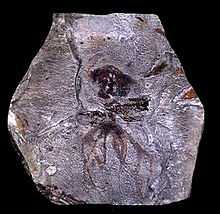Palaeoctopus
| Palaeoctopus Temporal range: Late Cretaceous | |
|---|---|
 | |
| P. newboldi holotype. | |
| Scientific classification | |
| Kingdom: | Animalia |
| Phylum: | Mollusca |
| Class: | Cephalopoda |
| Order: | Octopoda |
| Family: | †Palaeoctopodidae |
| Genus: | †Palaeoctopus |
| Species | |
| |
| Synonyms | |
| |
Palaeoctopus newboldi was a primitive octopod that lived in the Late Cretaceous, approximately 89 to 71 million years ago. Fossil material assigned to this species originates from the Mount Hajoula region in Lebanon. The holotype was found below the Old Covent, Sahel-el-Alma, Mount Lebanon and is deposited at the Natural History Museum in London.[1] It might belong to the Cirrina or be more basal in the Octopoda. Specimens from the Turonian of Mexico transpired to in fact be part of a coelacanth.[2]
A separate species, P. pelagicus, is known from the Early Turonian of Vallecino.[3]
See also
- Jeletzkya douglassae
- Pohlsepia mazonensis
- Proteroctopus ribeti
- Vampyronassa rhodanica
- 2009 extinct fossil octopus discoveries
References
- ↑ Woodward, H. 1896. On a fossil octopus (Calais Newboldi, J. de C. Sby, MS) from the Cretaceous of the Lebanon. Quarterly Journal of the Geological Society of London 52: 229–234.
- ↑ Schultze, H. P.; Fuchs, D.; Giersch, S.; Ifrim, C.; Stinnesbeck, W. (2010). "Palaeoctopus pelagicusfrom the Turonian of Mexico reinterpreted as a coelacanth (sarcopterygian) sular plate". Palaeontology 53 (3): 689. doi:10.1111/j.1475-4983.2010.00943.x.
- ↑ Fuchs, D.; Ifrim, C.; Stinnesbeck, W. (2008). "A New Palaeoctopus (Cephalopoda: Coleoidea) from the Late Cretaceous of Vallecillo, North-Eastern Mexico, and Implications for the Evolution of Octopoda". Palaeontology 51: 1129. doi:10.1111/j.1475-4983.2008.00797.x.